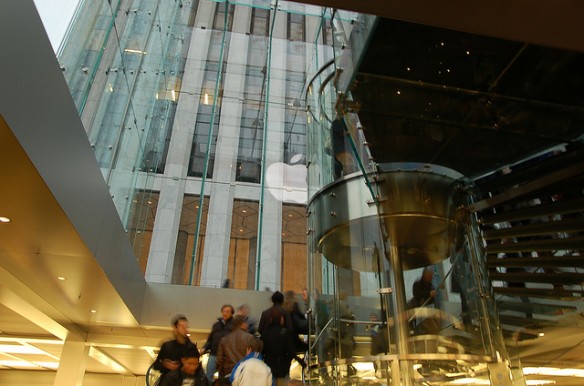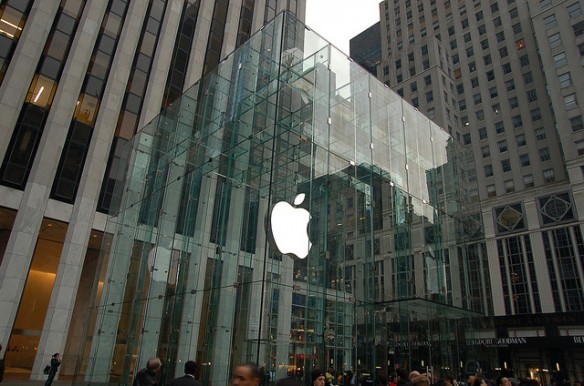On an early January visit to my sister in New York City, my family and I played tourists and walked around Manhattan, soaking up the city. We ambled up Fifth Avenue, passing by Rockefeller Center, St. Patrick’s Cathedral and scores of flagship stores of companies such as Fendi, Cartier, Gucci, and Giorgio Armani. On this fair Sunday afternoon, a day after New Year, many people were out strolling the avenue, and lines were formed outside several flashy stores, as evidently, some folks were not quite ready to end their holiday shopping spree.
One such store, perhaps one of the busiest (judging by the length of line outside and the amount of people inside), was the Apple Store across from the corner of Central Park. Inside, a frenzied crowd gathered around tables displaying Apple’s now iconic products (iPhones, iPads, iPods, and Mac desktop and notebook computers) and often had to wait in queues formed around the table for some hands-on time with the gadgets. As we climbed the stairs to leave, more people poured in. This particular Apple Store is open twenty-four hours a day, and according to a local friend, the store stays busy even at two o’clock in the morning.
The buzzing Apple Store on Fifth Avenue is emblematic of the company’s spectacular ascendancy from a significant but boutique computer company having less than 5% market share in the PC market to a leader and trendsetter in the sizzling mobile device market. Just three-and-a-half years ago, half the industry ridiculed Apple’s decision to enter the mobile device market with its first-generation iPhone smartphone because it was too expensive, required a data plan to which virtually no consumers were subscribing, did not support even the latest technical features (at the time, Bluetooth, 3G cellular radio, for example), and relied exclusively on a novel but untested user-interface component. Even Apple itself was cautious with its bold move at the time, and set a modest goal of reaching 10 million cumulative units in the device’s first eighteen months of sale.

In the Apple Store, trying to get out.
Since then, Apple has sold more than 41 million iPhones and a similar number of iPod Touches (which runs on the same platform and has a similar appearance and user interface), and has become a top-five handset maker in the world. In the last calendar quarter of 2010, Apple sold more than 16 million iPhones (as well as 7.33 million iPads, 19.45 million iPods and 4.13 million Mac computers) to reach $27 billion in revenue and more than $6 billion in profit. In comparison, during the same quarter, Nokia, which represents the old guard in the mobile device market and still is the overall leader in terms of unit shipment of smartphones and mobile handsets in general, had $17 billion dollars of revenue and $1 billion in profit. Apple, in a sense, opened the floodgate of consumer demand for data-centric smartphones and rode that wave to the very top.
A mobile carrier executive once sat in my office and marveled… “Half of those people have no business owning an iPhone; it does not make financial sense, they should spend that money on something else.”
As a former strategy and planning consultant who has had a fair share of clients in the mobile industry, I had a hard time getting clients (some are direct competitors of Apple) to understand why consumers would go crazy after a device that does not have the latest and the greatest technical feature, uses a carrier that is perceived to have poor coverage and customer service, and operates on a closed platform that is not compatible with devices from any other company. A mobile carrier executive once sat in my office and marveled at the long lines of people waiting outside his company’s retail stores waiting to get their hands on an iPhone, “Half of those people have no business owning an iPhone; it does not make financial sense, they should spend that money on something else.”
We can look to various external aspects of the iPhone in our attempt understand why people are spellbound by this little device. Is it the touchscreen? Perhaps it’s the Apps Store? How about visual voicemail and now video calls? While iPhone is no longer second-rate in technical features in comparison to other smartphones, and all these external factors related to product design do contribute to the device’s usefulness and user-friendliness, I believe I got a better feel of the source of the device’s magic after I came out of that Apple Store on Fifth Ave.
Through carefully crafted product design and marketing strategies, Apple has elevated the status of its products from mere useful gadgets and communication tools to that of high-end fashion accessories, jewelry, and cultural icons. While its competitors are selling devices that are seen as gadgets and tools—and therefore have to be evaluated by the cognitive mind on their usefulness, cost, and technical prowess—Apple’s devices are akin to a Gucci dress, a Fendi handbag, or a Cartier diamond ring (all of which have glitzy flagship stores on Fifth Avenue) that carry an allure and appeal to consumers’ rawer senses and emotional longings. These items are not highly prized simply because of the material functions they can perform, nor by their usefulness, but by the their ability to gratify people’s deeper and rarefied desires for material wealth, social status, and a commercially-enshrined and internalized sense of beauty.
The attraction actually took place when the eyes set on the simple and slim form, the bright, high-resolution screen, and when the hands feel the curves and textures of the body….
While it’s sensible to perform and provide a rational assessment and justification for purchasing a useful tool, when do we need any justification to indulge in something that simply makes us feel good? The fact that Apple’s devices are actually useful in many ways only serves as fodder. The attraction actually took place when the eyes set on the simple and slim form, the bright, high-resolution screen, and when the hands feel the curves and textures of the body—not too light, not too heavy, not too slippery, not too scratchy. The mouth salivates and bends to a smile. It’s all over. Now the cognitive faculty needs to catch up and figure out: “How can I own this piece of gem?”
How much of our lives are driven by experiences, contacts, and feelings like that? How can our rational mind catch up to it to claim any freedom of will? Do we have any way to gain access to that deeper part of our mind that drives us, or are we hopeless in the moment-to-moment rush of longing and satiation?

